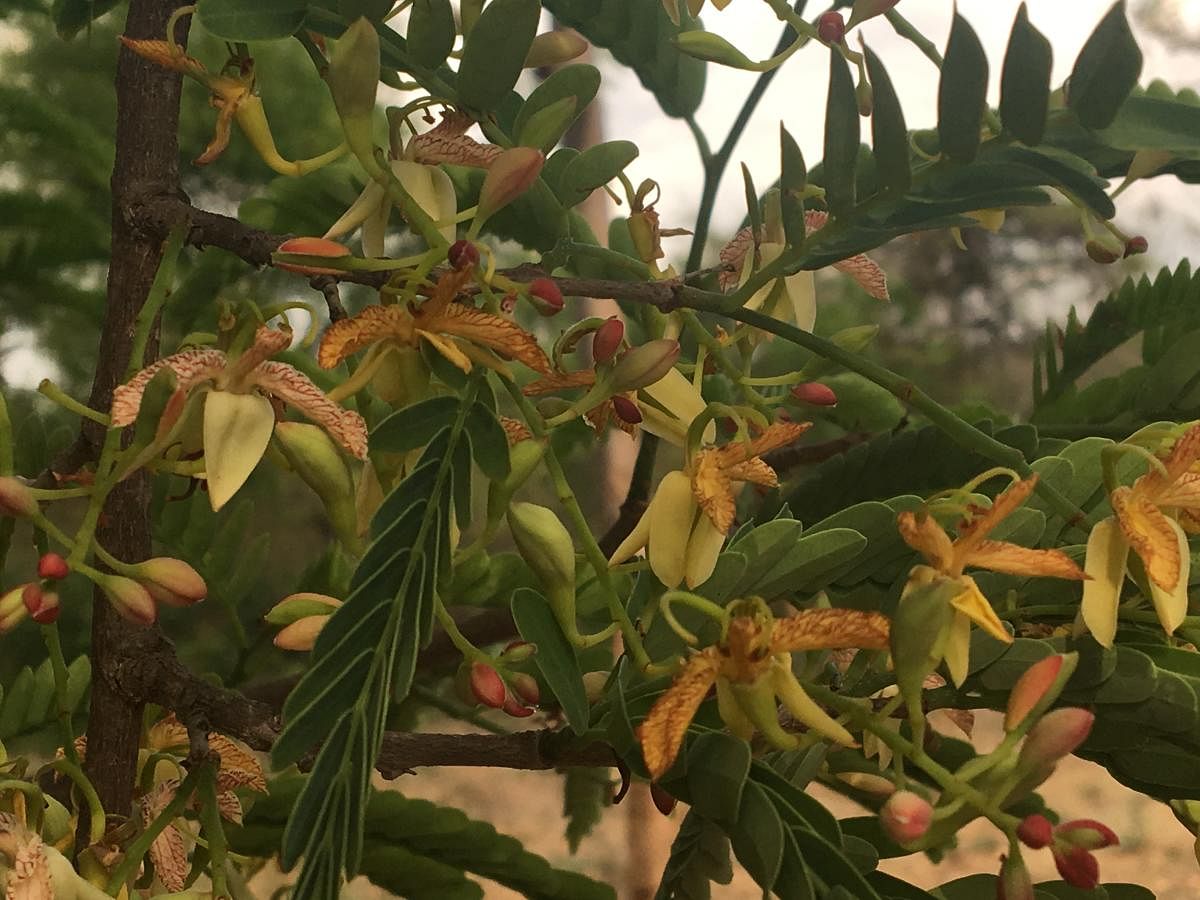
The tamarind tree shook vigorously for a whole minute. It then went still….and then shimmied again, and again, grooving to a beat I couldn’t hear.
It was a late February afternoon. I was rousing from a nap after a sweltering half-a-day on the field and the sight of a tamarind tree gone mad outside my window was befuddling.
Mercifully, this was no possessed tree from the many ghost stories that feature these giant trees but just our expert tamarind harvesters shaking the tree to loosen ripe pods.
Like everything in nature, our 10 tamarind trees lead busy lives throughout the year. I eagerly wait to find out what they are up to during every trip to Navilu Kaadu.
So here’s what I learnt of the tamarind’s year-long journey, from dainty bud to sticky brown condiment, a staple in most Indian kitchens.
Our trees and their brethren in the region — there are many by the wayside and on neighbouring farms — adorn themselves with delicate pink buds in April, to coincide with Ugadi festivities. The buds soon bloom into gorgeous, red-tinged yellow blossoms. Then they turn into fruit and tiny green pods appear in October during Dasara. The raw green pods grow in size and ripen over the chilly winter months.
Summer's cottage industry
Between February and March, when the sun is northward bound, our 10 beauties stand studded with chocolate-hued sweet-sour tamarinds. The gummy insides turn deep amber with brittle outer shells. Fruit bats and parakeets throng the trees to feast on the tarty treats.
It is that time of the year when our stock is especially high in the neighbourhood, thanks to our fruiting tamarind trees. The village plumber, mason and electrician, who otherwise vanish without a trace during emergencies on the farm, resurface with bids to harvest our fruit-laden trees.
Tamarind harvesting and processing is a summer’s cottage industry around Navilu Kaadu and follows the winter horse gram harvest season. Village roads transform into tamarind drying yards. It is a laborious affair and women, men and children of all ages join forces for what is a family enterprise.
During the pandemic, with my family stationed at the farm, we ventured to harvest and process the produce in-house.
We spread bright blue tarpaulins beneath the canopies of nine of our tamarind trees to catch falling pods. The 10th tree by our southeastern boundary had house guests, a pair of nesting purple-rumped sunbirds.
We left the tree with its fruits intact and its residents undisturbed. It is an immense privilege to be able to make such decisions, while our fellow farmers live precariously on the edge, trying to make the most of every harvest, for a smidgen of profit.
Back to our harvest, the nine tamarind trees received mighty shakings like the one that shook me out of my snooze.
Pods stubbornly clinging to the branches were either given a pasting with a stick or sliced off with a harvesting pole.
We gathered the harvested pods and dried them in the sun for about a week. The stickier the fruit, the longer it needs to stay in the sun to dry the sap. The men then had a go at the sun-dried pods, giving them a furious thrashing with wooden sticks, separating the brittle hull from the fruit.
Women gathered the dehulled fruits and removed the fibre. The boys and I joined the women, and together, we clobbered the fruits with wooden pestles on blocks of stones, sending tamarind seeds flying in all directions. We pressed back the flaps of the deseeded fruits exposing the white inner lining. We then lumped together the fruits to form cakes of processed tamarind.
So goes the story of the ambrosial tamarind that survives fierce shaking and walloping to reach your kitchens in the form it does, and works its magic on lip-smacking curries, sauces and chutneys.
As we prepare for this year’s harvest at Navilu Kaadu, I leave you with this recipe for ‘Kuttunde’, a delightful tamarind treat from my childhood: Take a fistful of tamarind, throw in a teaspoon of roasted cumin powder, some red chilli powder, salt and jaggery to suit your palate. Give it all a sound pounding, roll into bite-sized balls, stick them to spoon ends and suck away.
Rooting For Nature is a monthly column on an off-kilter urban family’s trysts with nature on a natural farm.
The author chipped away at a software marketing career before shifting gears to communications consulting and natural farming. She blogs at www.bluejaydiaries.com and posts as @ramyacoushik on Instagram